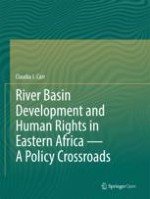High Seismicity in the Gibe III Dam Region
The significance of the 1906 is twofold: 1) It demonstrates that earthquakes capable of producing destructive to ruinous shaking intensities can occur within the rift zone, and 2) it demonstrates that like the Juba, Sudan swarm, areas along the rift that had been relatively quiet prior can produce large earthquakes—present activity is no guarantee of future activity, as it were. 3
Even one moderate (magnitude 5 to 6) earthquake every five years in the zone of the Gibe III dam would be reason for concern, and the fact that the zone is subject to bursts of seismic activity poses an even greater risk, as there would be little time to repair damages to structures between one earthquake and the next. The cumulative impacts of these clusters would be greater than any individual M5 earthquake.
Date | Magnitude (NEIC) | Magnitude (Gouin) | Distance from Gibe III (km) | Distance from Plate boundary |
|---|---|---|---|---|
25 Aug 1906 | 6.6 | 185 | 35 | |
28 Oct 1906 | 6.? | ? | ? | |
14 Jul 1960 | 6.3 | 134 | 23 | |
23 Jan 1968 | 5.1 | 5.1 | 207 | 152 |
2 Dec 1983 | 5.1 | 145 | 40 | |
20 Aug 1985 | 5.4 | 196 | 42 | |
10 Jul 1987 | 5.3 | 89 | 11 | |
25 Oct 1987 | 5.6 | 171 | 19 | |
28 Oct 1987 | 5.4 | 137 | 3 | |
8 Jun 1989 | 5 | 63 | 15 | |
13 Feb 1993 | 5 | 274 | 11 | |
20 Jan 1995 | 5 | 130 | 17 | |
19 Dec 2011 | 5.1 | 95 | 59 |
[T]the region around the project area has a recorded history of significant seismic events. The outcome of our study shows that projects such as GGII, GGIII, and GG IV should consider seismicity into the design and construction processes. Neglecting the risks posed by seismic hazards in such a region with [sic], we believe, has tremendous negative consequences in the future usefulness of these projects. [Emphasis added.]
Reservoir Seepage and Landslide Danger at the Gibe III Dam
Even if the dam itself remains intact after a seismic event, it is highly plausible that springs, leaks and seepage developing in the adjacent rock abutments could cause a dam failure. This danger stands despite the design of the Gibe III dam calling for ‘grouting fractures’ within the native rock around the dam.
The high probability of landslides, along with highly likely buildup of sediment behind the Gibe III dam - even with mild to moderate earthquake occurrence, let alone a major seismic event—presents a risk to the dam’s integrity. Sedimentation is promoted, for example, by soil erosion upstream—exacerbated by deforestation and overexploitation of soils for agriculture.
In Vaiont, more than 2600 people were killed when 260 million cubic meters of a slide block moved suddenly into the newly filled Vaiont Reservoir – behind a very tall dam that blocked a deep valley. The intensive landslide occurred within seconds and displaced more than half of the reservoir’s water, generating a giant wave that reached a height of 250 meters which then created an enormous wall of water that swept into nearby villages and towns, destroying everything in its path. The dam itself remained intact. In the Vaiont case, the rockslide and ensuing flood could have been readily foreseen by logical consulting. The cause of the landslide may also be pertinent to a consideration of the Omo situation. The sedimentary rocks of the Vaiont River Valley include layers of shale, a clay-rich rock. And the rocks comprising the nearby mountain (Mt. Toc) tilt steeply toward the reservoir. When the dam was finished in 1960, filling of the reservoir introduced groundwater into the shale layers, causing them to swell and become unstable. At first, the mountainside began slowly creeping down slope at a rate of half an inch per week. As filling continued and more groundwater seeped into the mountain, the rate of slippage increased to eight inches per day, and ultimately to 30 inches per day, just before the 1963 disaster. [ARWG earth scientist, personal communication]
Failed Government and Development Bank Seismic Review
As evidenced above, both the GOE timeframe and geographic scale are far too narrow to effectively determine seismic risk. Section 5.13 of the GOE’s assessment, by noting only earthquake occurrences within the recorded time, clearly implies that this narrow window of time is indicative of the (lack) of potential for future earthquake activity. Typical seismic design, however, looks much further back in time to faults showing activity.
